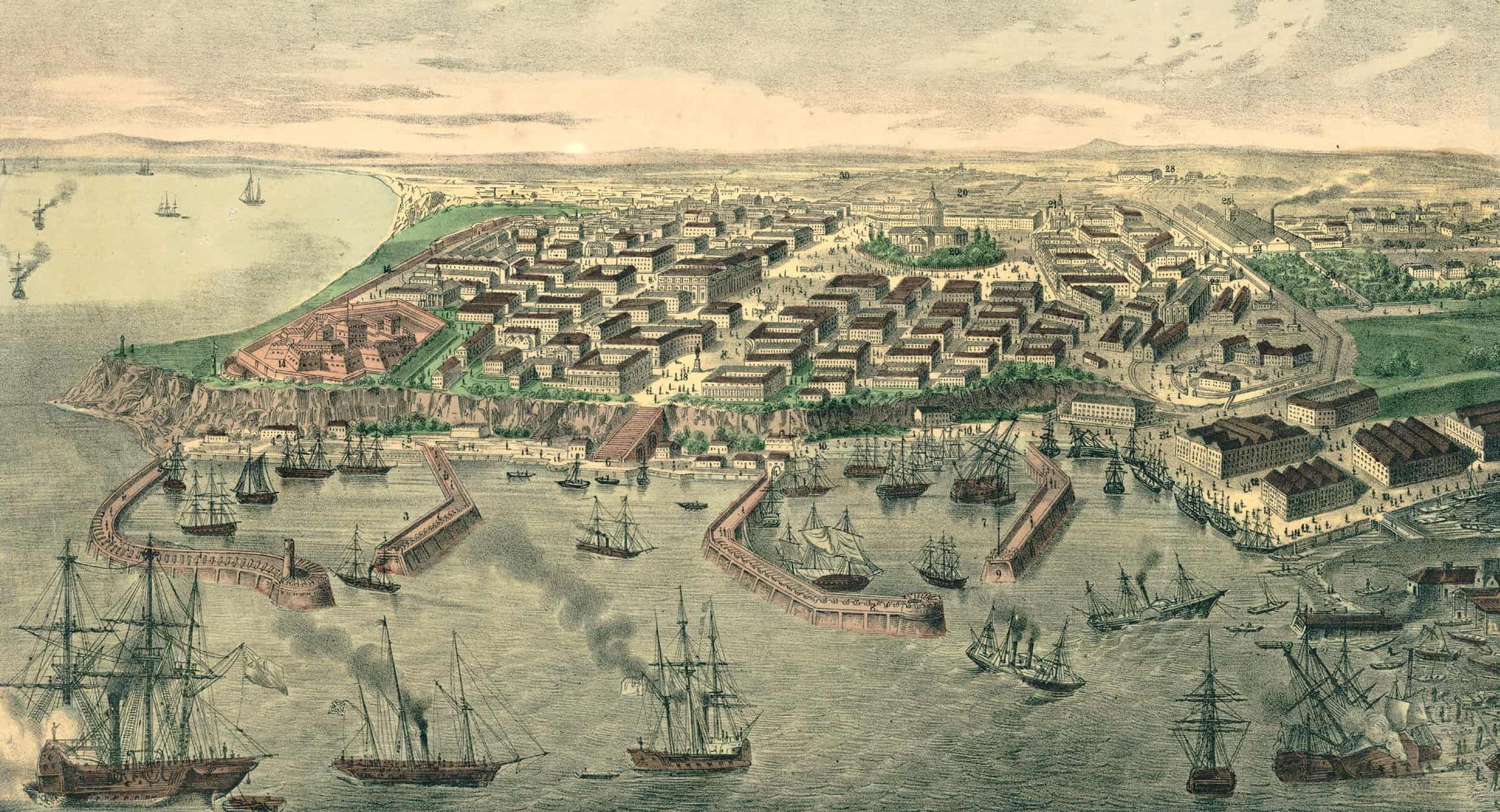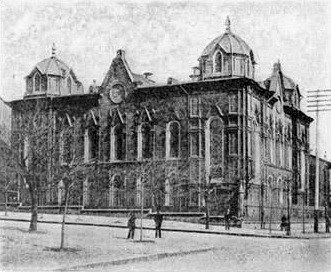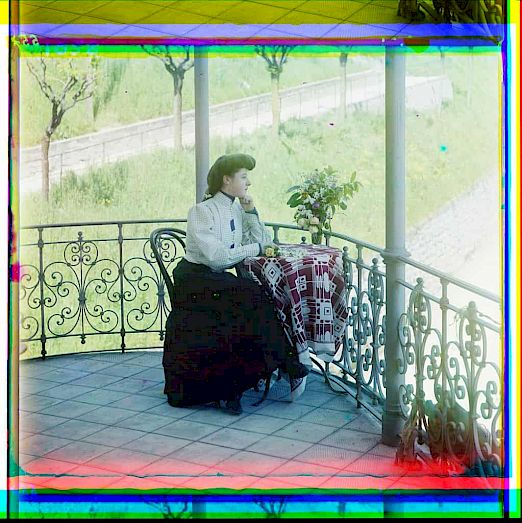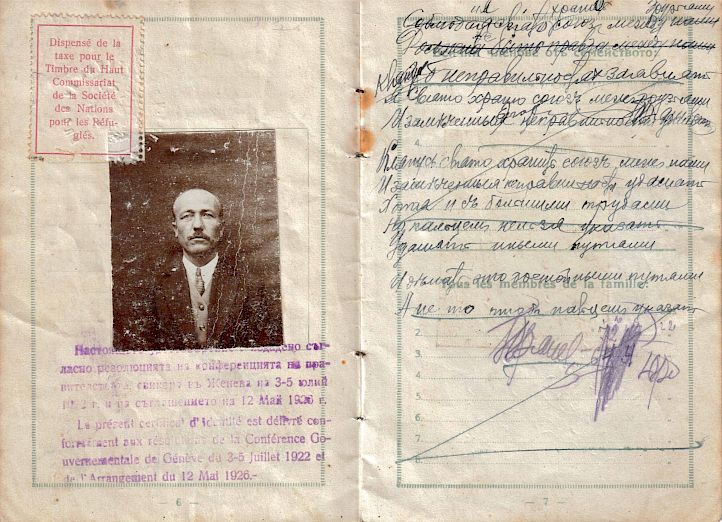Down Under, Transnational, Global: Exploring Russian and Soviet History with Philippa Hetherington
The Black Sea is in the news for all of the wrong reasons these days. Whether it's the Russian annexation of Crimea, uncertainty surrounding the outcome of parliamentary elections in Moldova, or the breakdown of Moscow's plans to conduct a natural gas pipeline to Europe via the Balkans, these former Tsarist borderlands (and shores) have become an object of geopolitical intrigue that few would have predicted only a year or two ago.
Lost among fears of a revived Cold War is another ongoing crisis in the region: namely, sex trafficking, or what earlier generations would have known as "the traffic in women." Even as countries like Russia are some of the largest destination for immigrants from other parts of the former Soviet Union, Moscow's former western borderlands–Ukraine and especially Moldova–constitute some of the largest "exporters" of women into the international sex trade. Sold into criminal gangs as "white" women, women from these countries may find themselves trafficked to brothels in Russia, Turkey, Israel, the UAE, or other destinations. For countries like Ukraine and Moldova, where per-capita income is the same as in Sudan, human traffickers find ideal conditions, helping make human trafficking the third most lucrative criminal enterprise in the world, according to the United Nations.
The human trafficking crisis may be forgotten in the light of the region's other ongoing problems, but like disputes over Ukraine's place between Europe and Russia or the geopolitics of energy, it, too, has a history. Indeed, perhaps obviously more so than these other two regional problems, the history of "the traffic in women" has obviously global dimensions. Women kidnapped from Chisinau, Kiev, or Minsk may belong to individual nation-states, but the networks that disappear them–and the states and international agencies that sometimes seek to rescue them–are engaged in a battle that takes place above, over, and through the lines on a map. But more than simply reifying all-too-frequent panics over sex trafficking, global history scholarship on the history of sex trafficking must not ignore larger dimensions of racial hierarchy or global migration writ large.

Such nuances lie at the heart of the work of the latest guest to the Global History Forum, Philippa Hetherington. In her work, the recent Harvard PhD explores the emergence of "trafficking in women" as a specific crime in fin-de-siècle Russia, arguing that the legal battle against sex trafficking needs to be understood in terms of larger, global dynamics not unique to just Russia. Working at the intersections of Russian and global history, Philippa recently took time out from her current post-doctoral fellowship at the University of Sydney in her native Australia to speak about her work.
•
Hetherington's interests in history go back a long way–so much so, she jokes, that she feels embarrassed about how much it seems like it was destined from the start. Born in Sydney, Hetherington spent her childhood in the Australian capital of Canberra, where she grew up in a household full of military and political history books. "My dad was obsessed with Australian history, British history, military history–the whole gamut," she says, and very quickly history and literature came to be her favorite subjects at school.
Yet the fact of coming to Russian history was serendipitous. After completing her primary schooling in Australia, Hetherington traveled to England for her secondary schooling, where history lessons consisted of a mix of ancient history, British history, and modern history. "I sort of 'missed' Australian history," she jokes. But Russia stood out as an odd place of contrasts. Coming from a "big hot place" on one side of the planet, Russia qua "big cold place" stood out as mysterious.
Little did she know that there was already a rich tradition of Australians working on the country: as most specialists will know, the renowned University of Chicago historian Sheila Fitzpatrick hailed from Australia (her father was the popular historian Brian Fitzpatrick); fewer may know that the scholar of Russia Katerina Clark (of Yale) came from Down Under, too, or that her father was the famous Manning Clark, the father of Australian historiography. Historically, Hetherington explains, studying the Soviet Union seemed like a natural vocation for members of an Australian Left who felt alienated from the possibilities of politics back home during the 1960s and the 1970s.
Back in Sydney for her undergraduate studies, however, Hetherington had different ambitions. Russian Studies remained relatively underdeveloped in Australian universities, so she had to put together a course of language study, including private tutors, to make things work. Originally intending to complete a law degree after her undergraduate study, Hetherington then decided to take some time off from the most obvious professional path and teach English in St Petersburg. In spite of the culture shock in the "big cold place," however, Hetherington became intrigued. Not only was there the chance to finally explore some of the places she had only read about to that point (it was her first time there), but the "gender binary" of the place fascinated her, too.
"There was a real pressure then to present oneself in either a hyper-masculine or hyper-feminine fashion," she notes. The lessons she had drawn from undergraduate coursework in gender studies seemed more relevant than ever, even as Russian gender norms confused her at times. After a brief spell teaching English in Belgrade–her Russian visa had expired and Moscow had implemented new visa rules for Australian nationals–Hetherington deferred her law degree and applied to graduate school to pursue Russian history. Acceptance letters arrived in the mail, among them one from Harvard, and that autumn, Hetherington was traveling to the United States to begin her doctoral coursework.
We discuss Hetherington's fields and her path to global themes in her work. There's an irony, she notes, in the fact that she ended up working on global topics–Harvard offers a field in global and international history, but she ended up choosing Russia, gender, and Central Europe as her areas of specialization. The first involved a thorough training with Professors Terry Martin and Kelly O'Neill, specialists in Soviet History and Tsarist History, respectively. The second involved working with professors like Judith Surkis, Afsaneh Najmabadi and Nancy F. Cott. But it was in doing a Central European field with Professor Alison Frank Johnson that Hetherington felt her interests shifting. "Professor Frank Johnson was already interested in internationalizing the history of Central Europe," she explains, "and the gender and sexuality field was already very multi-national in itself. I was always reading about other contexts, other national fields in which problems had suggested themselves." Asked for particular works that inspired her, Hetherington is quick in her response: Mrinalini Sinha's Spectres of Mother India. She's read the work dozens of times, she explains, and it remains the book on her bookshelf that she continues to return to when faced with doubts about a research problem.
We ask Hetherington about any perceived holes in her education at Harvard–for improvements in the way that global history could work as a part of curricula. She says that she would have loved to do an international history field with Professor Erez Manela or David Armitage, even if time and pressures didn't allow for it earlier. Nonetheless, echoing familiar concerns for the field of global history, she adds that she would not have wanted to give up an area-specific field (in her case, Russia). Working with Martin and O'Neill, she notes, gave her a deep and crucial background in Russian Studies that she was able to draw on later, even when approaching apparently inter- or trans-national topics. And tempting as it might be for scholars to rely primarily on English- or German-language sources, it's important for a young field to be honest on the promises it can deliver on–global should mean global, not just imperial, much less national, history. It should thus incorporate 'non-Western' parts of the world, such as Russia, on an equal level with the anglophone and west European sphere.
That area studies background mattered, since it was Russia–or, rather the former Russian Empire–where Hetherington found herself after her first year in Cambridge. Harvard PhD students, she explains, have the unusual privilege of being able to receive funding for pre-dissertation research—basically, exploring the archives and libraries they might eventually need for a putative project, getting their footing before facing pressures of time and funding. Hetherington knew that she wanted to try to de-center the Russian History field away from Moscow and Petersburg, and wanted to work on gender in one way or another. After reading works like those of Russianist Nick Barron, moreover, space was a concern–"how spaces were connected among empires." In a familiar experience, however, initial trawling through libraries turned up plenty of possible leads, but nothing definite.
The epiphany, Hetherington explains, came during a trip to the Ukrainian Black Sea port city of Odessa. Hetherington had made her way to the provincial archive in the city, and at first the pattern (interesting files, but nothing definite) seemed to be repeating itself. Yet Hetherington soon found her break. In what may sound odd, but is actually a familiar experience for many historians of the Russian-speaking world, an insistent and motherly archivist demanded that she take a look at several files on prostitution in 19th century Odessa. Local authorities, she explained, had been conducting court cases against accused human traffickers, who then rejected the Russian authorities' claims of competence on the grounds that they were Ottoman citizens.
Still, the Tsarist authorities seemed convinced (if not paranoid) that a vast transnational criminal operation was enslaving "white" Russian women and impressing them into sex slavery. Hetherington recalled some of her earlier readings in the gender and sexuality field, where she had learned of how contemporary British reformers wrote incessantly about what was then called "white slavery" (i.e. the international trafficking of women for sex). Hetherington took extensive notes on the Odessa files, then returned to St. Petersburg, where she began scouring the central Tsarist archives for information on "торговля женщинами" ("the traffic in women," the Russian term for the sex trade). Files poured out, ranging across conventional temporal boundaries (some before the First World War, some during …) and a vista of potential research opportunities opened itself up. Over the course of the next several years, then, Hetherington spent much time moving between Petersburg, Odessa, the Baltics, and Moscow to track the history of 'the traffic in women' as a social problem in imperial Russian and Soviet law and society.
As Hetherington explains, however, the ambit of her work soon went beyond that. Although there were plenty of specifics to the case of Russian trafficking, thanks to her ongoing reading for general exams ("Comps"), she knew that there were multiple ongoing historiographical debates about the "border politics" and "biopolitical strategies" of other contemporary empires when it came to sex traffic: Judith Walkowitz's City of Dreadful Delight, published in 1992, or, to take a more recent example, Stephanie Limoncelli's The Politics of Trafficking. Likewise, scholars like Marilyn Lake had made her wise to the history of immigration as a global problem.
But Hetherington also recognized that to contribute to this literature in a significant way, she would have to focus not only on Petersburg or Moscow as receiving nodes for sex traffic (as much scholarship on Amsterdam or London as red light metropoles had done). The Russian Empire "exported" more women than it "imported." More than that, however, she adds, "I realized that I needed to study both sides of the border." Women couldn't simply disappear from her story once they disappeared to Constantinople or receiving markets further afield; she would, she realize, need to dig around not just in the archives of Odessa or Petersburg but also those of the League of Nations, in Geneva.
Put it all together, and what you'll find as a reader of the dissertation–soon a manuscript on some eager editor's desk, one hopes–is an exploration not only of the Russian and Soviet state's relationship to sex trafficking, but also of the ways in which the very framing of "the traffic in women" as a transnational phenomenon encouraged new national claims to power. "The category of the 'traffic in women,'" writes Hetherington, "linked urban, domestic/national, inter-regional, and international politics and practices of governance in ways that simultaneously reified a realm of transnational humanitarian and legal cooperation while consolidating the notion of geographically defined nations or empires through the assertion of claims to border sovereignty and surveillance. However, the work done by the idea of trafficking was not only to connect these different scales."
More fundamentally, the creation of "trafficking" as a crime "It was also to produce the notion that the 'transnational' existed as a scale at all, linked to but ultimately independent of the domestic, and vice-versa." This elaboration of a transnational scale of crisis then legitimated national governments, like the Tsarist autocracy and, later, the Bolsheviks, to elaborate an internal national or imperial scale over which they could claim increased powers in light of transnational crises.
The dissertation illustrates this methodological point–important for scholars working on transnational topics in other realms–through a diachronic history of "the traffic women" across several decades. In Tsarist Russia, Hetherington shows, prostitution was officially tolerated and regulated since 1843, but in such a way that required local prostitutes to register with local police. The system of so-called "yellow tickets" fixed prostitutes to space in the vast Russian Empire, but at the same time this enforcement of a national "inside" generated fears about "secret prostitutes" reputed to be working illegally, spreading syphilis with them.
After the Revolution, Bolshevik authorities criminalized the operation of brothels and cracked down on Johns, but only fickly prosecuted prostitutes themselves. According to the new Soviet leaders, prostitution was the result of deformed capitalist labor relations, not a moral choice. Once the Bolshevik's early New Economic Policy resulted in an influx of unemployed women into the cities, however, imaginaries of an elaborate international criminal network spreading disease re-entered Soviet official discourse. By the early 1930s, a newly carceral approach had re-entered Soviet politics. Prostitutes populated "corrective labour camps" (the precursor to the GULAG), while abortion and pornography were soon made illegal. All of this was to say nothing of the hundreds of thousands of women who had already left the former Russian Empire during the Civil War (of whom more in a moment).
In covering this huge story, Hetherington makes a significant contribution to the literature on sex and space with special reference to the Russian Empire and the Soviet Union. Basing her investigation on works in British Imperial history by historical geographers like Phillip Howell, Richard Phillips and Stephen Legg, Hetherington is interested by the ways in which the regulation of imperial space creates or enforces "segregated spatialities of colonial urbanism" (in the words of Howell). And while Russian historiography boasts a rich tradition of problematizing space that dates all the way back to late Tsarist geographers, even after significant work in the field by historians like Mark Bassin, Christopher Ely, and Melissa K. Stockdale, Hetherington contends that there remains a ways to go as far as spatial histories of gender are concerned.
And yet what better analytical category is there to see how empires imagined their own topographies? As Hetherington's dissertation shows, throughout the late nineteenth and early twentieth century, locales like the wartime front (a potential breeding ground for syphilis), colonial outposts (a space of segregation between "natives" and Slavs), or railway stations (sites of political subversion as well as disease transmission) were all bound up in sexual imaginaries of space. Where Hetherington breaks real ground, however, is not only in pointing out the fact of sites "inside" empire where hierarchies revolving around gender expressed themselves. Instead, it's to show how the emergence of perceived "transnational" crimes paradoxically paved the way to a further disciplining of sites inside national borders. As if building upon the work of American studies specialist Amy Kaplan, Hetherington's work demonstrates how "the national" and "the transnational," far from exclusive categories, are actually mutually constitutive of one another.
Perhaps the Soviet Union's interactions with the League of Nations illustrate Hetherington's methodological intervention most clearly. Her initial interest in the interaction between the two institutions grew out of a puzzle. After the Soviet Union became a member of the League in September 1934, she explains, it signed on to existing League treaties on the suppression of pornography, but not to anti-trafficking treaties. Why the discrepancy, she wondered? Drawing on research in Moscow and Geneva, Hetherington's research explains the Soviet state's relationship with the "international" scales produced by the League.
The story begins in Constantinople in the early 1920s, one of the first points of arrival for the roughly one million former citizens of the Russian Empire who had fled Eurasia during the Civil War. From 1917-1921, the status of these people was up in the air: some had identification documents produced by the ancient régime, others none, and the Revolutionary process made ambiguous what the status of old Tsarist documents was, anyway. But in 1921, Bolshevik authorities declared null and void any claims to Soviet citizenship made by Russian citizens who had left the country since November 7, 1917 (the date of the "October" Revolution, which took place while Russia still followed the Julian calendar). Furthermore, anyone with Russian citizenship who had lived outside of Russia before 1917 had to re-apply for Soviet citizenship.
In the context of places like Constantinople or Shanghai, with large White Russian communities, the result was chaos. Newly undocumented White Russians constituted a headache for Turkish authorities, who were reluctant to issue them visas. So-called Nansen Passports helped some, but many Russian women ended up working in prostitution as a result of their legal aporia and lack of economic resources. These women's plight may have been a result of Turkish or Chinese intransigence to a certain point, but the more immediate reason for their statelessness was the insistence of the revolutionary regime in the USSR to define them as "outside" of a Soviet polity. It was a neat way for Moscow to get around the terms of existing international migration law, which typically stated that trafficked women (in this case, White Russians), if found outside of "their" national borders, were to be returned to their country of origin. In the case of the Russians in Constantinople, they had no such home country–they were stateless.
Yet, tellingly, the Bolshevik attitude towards the League was not one of pure rejectionism. Moscow shelved an early League international anti-pornography agreement out of concerns about the applicability of international law to a federative union, but in 1935, authorities were willing to accede to such a treaty. This should seem odd: unlike anti-pornography activists today, contemporaries made a more direct association between pornography and the trafficking of women. Sex-addicted men, it was thought, were more likely to frequent unregulated brothels, thus driving the traffic in women.
Moscow, however, asserts Hetherington, was arguing for a different form of biopolitics. Internally, the suppression of pornography "fit more obviously within a legal regime in the mid-1930s that focused heavily on strict censorship and the excision of any undesirable discourses from the body politic." Yet in defiance of the League's international order, once debates about the traffic in women moved from a ban on publications to questions of sovereignty and people, they asserted a national (or imperial) scale of sovereignty within which "international" concerns were void.
The USSR's rejection of trafficked bodies as legitimate members of its own national community became a constant source of stress vis-à-vis relations with the League. In late 1927, League authorities , distressed by earlier findings in Turkey, sponsored a number of covert investigations into the status of Russian women, who had become a cipher for human trafficking writ large. And in 1930-1932, the League, funded by the Rockefeller Foundation, conducted an open mission to Southeast and East Asia to investigate the situation of Russian women in port cities there. Their investigations found that Russians were, uniquely among "white" women, victims of trafficking. Shocked, Western humanitarian organizations (especially in London) vended an image of former Russian nobility forced by penury into sex work. Likewise paradoxically, these same organizations devoted to the most wretched of the wretched–"humanitarian" concerns–emphasized the risk of elegant white women falling into the clutches of "yellow" Asians (particularly as Japan had recently invaded China). Concerns over Korean sex slaves trapped by Japanese colonial rule (for example) went undiscussed, needless to say.
Hence the paradox that Hetherington's work uncovers. On the one hand, League organizations "produced a paradigm of the trafficked subject whose abjection was the result of the particularly repressive operation of sovereign power by the Soviet Union over its borders. In this way, the Soviet state was implicated in the reframing of the problem of trafficking in the interwar era, even as it insisted on immunity from trafficking as a cross border crime." The transnational and the national as scales of crime and sovereignty, respectively, were efforts of narrative to include or expel troublesome bodies from various polities. But the elaboration of a "transnational" scale that supposedly justified interference into "domestic" Soviet affairs also tended to reproduce existing hierarchies of power having to do, as the case of East Asia shows, with class and race. None of this is to cast aspersion on the motivations of contemporary activists. But it does constitute a healthy reminder that the claim to a realm of transnational politics somehow beyond the fractals of domination at the national scale–whether through human rights, anti-trafficking, or drug control–is bound to be illusory.
Given the persistence of transnational phenomenon precisely like these, historians always run up against the difficult question of where to end such stories. The bulk of Hetherington's dissertation tracks the period from the second half of the 19th century to the late 1930s, when the League's Committee on the Traffic was dissolved. She initially intended to end the story there (although there's obviously a huge, untold story of trafficking during the war years), but decided to end the dissertation with an epilogue on the Soviet Union's 1954 accession to the United Nations' 1949 Convention for the Suppression of the Traffic in Persons and the Exploitation of the Prostitution of Others.
Now a forgotten moment in the history of human rights, the Convention marked a huge step forward in abolitionists' crusades "by being the first (and only) to reference prostitution as well as trafficking in its title, and explicitly requiring party states to commit to fight against all forms of 'exploitation of prostitution' inside as well as across their borders." Old terms like "white slave traffic" that laid bare hierarchies of value were replaced by more neutral terms. Not only that, earlier burdens of proof that required investigations to prove the profitability of trafficking before prosecution could start were removed.
Who could disagree with that? Historically, the answer had been regulationist countries like France that disagreed principally with the attempt to eradicate prostitution inside national borders. By 1947, however, France had itself abolished regulation. But there was a new issue on the table: the so-called "colonial clauses" in drafts of the treaty. Traditionally, anti-trafficking instruments contained clauses that allowed signing parties (London or Paris, for example), to exclude their colonial dependencies from the jurisdictions of such treaties on the ground that they were not independent actors. The USSR smelled blood–it had no official colonies, after all–and lobbied for the deletion of such colonial clauses from the Convention. When the Convention came up for vote on December 2, 1949, Moscow voted "yes" alongside formerly subaltern states like Iraq, India, Pakistan, and Syria; the British and the French were the only "No" votes, while Washington abstained.
Hetherington's dissertation points towards a huge and still largely untold story, namely the global history of trafficking between 1949 and 1991. Even as many states refrained from signing the agreement (major receiver countries, former empires, and post-colonial states among them), Hetherington's epilogue notes that there is still an ambiguous story to be told of the relationship between the Soviet Union, the Third World, the United Nations, and the Cold War-era rise of institutions like the U.N. Working Group on Slavery (founded in 1974). It was the early years of the Soviet-Third World alliance, arguably, that laid the institutional bedrock for these latter institutions that served as organizing poles for the women's rights NGOs more familiar to post-Cold War discussions about human traffic.
Still, she concludes, the point is that debates about "the traffic in women" are not always about the protection of women against exploitation. "The exact wording of the Convention on the Traffic in Persons," she explains, "was arguably as much about Soviet attempts to assert a socialist-Third World moral alliance against the imperialist West as it was about substantive debates over the nature of women's capacity to consent to migration for the purposes of sex work." Like it or not, this political and ideological dimension to what might seem like a cleanly humanitarian issue persists to this day. One hopes that through more work like Hetherington's, activists and international lawyers can understand the fraught historical and ideological baggage regarding norms of sovereignty that countries–whether "receivers," "senders," or both, like Russia–carry with them into debates about human trafficking.
•
Since receiving her PhD from Harvard this May, Hetherington has been active as a Postdoctoral Research Fellow at the Laureate Research Program in International History at the University of Sydney. The program, headed by international historian Glenda Sluga, was recently funded by the Australian Research Foundation with the aim of strengthening the discipline in Australian universities. There, along with colleague Sophie Loy-Wilson (whose work focuses on the history of "coolie" labor in the Asia-Pacific region), Hetherington is contributing to a program that seeks to explore the connections between the history of the international economy and ideas of international society.
Next September, however, Hetherington begins a position as a Lecturer in Modern Eurasian History at University College London, during which time she will likely turn the dissertation into a scholarly monograph and begin work on a second project. Her dissertation, she says, grew out of concerns with gender and sexuality, but the process of writing revealed hers to be a story that is also about the rise of border controls, "sovereignty panics," and global discussions about migration controls writ large. While focusing on the book manuscript, then, Hetherington is also writing an article on Russian Imperial shipping agents who worked with companies in Austria-Hungary and Prussia–a story that tells us about the Russian Empire, but also about the early development of international migration law.
A mix of interests like these makes Hetherington's a welcome presence in Sydney and London alike. Given the scale of her first project and the breadth of her interests, we know that we at the Toynbee Prize Foundation will not be alone in following the future historiographical paths blazed by this historian hailing from "the big hot place," but working on the history of "the big cold place"–doing it, all the same, in a global context.




